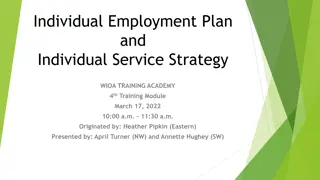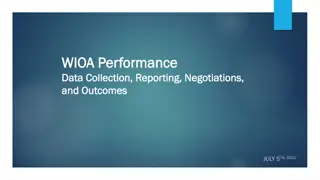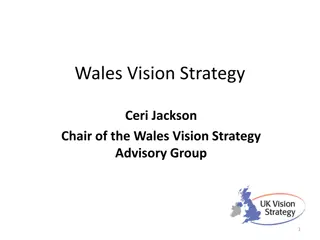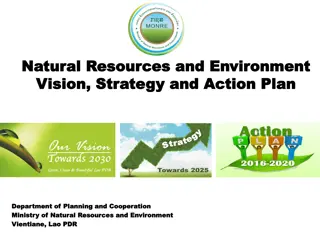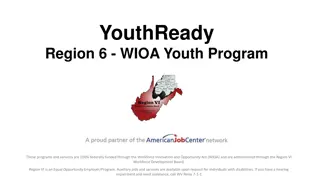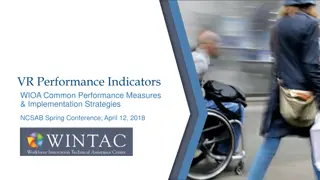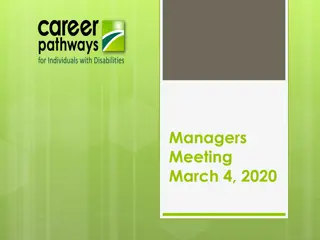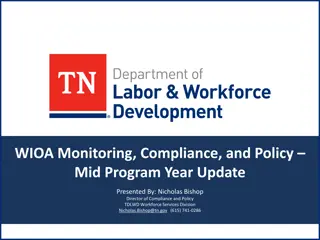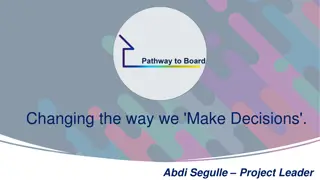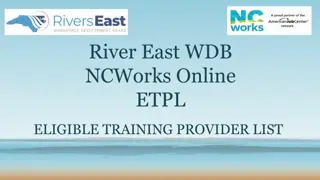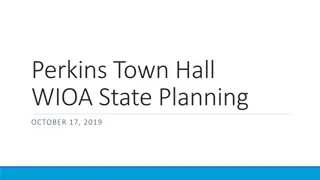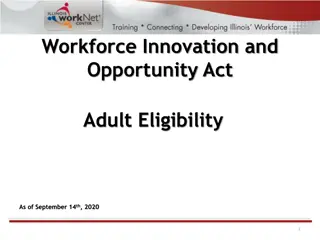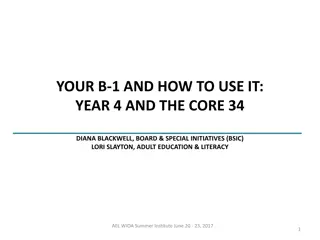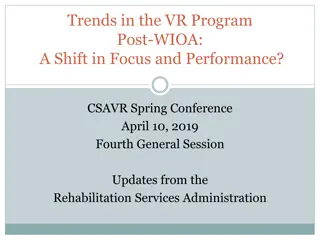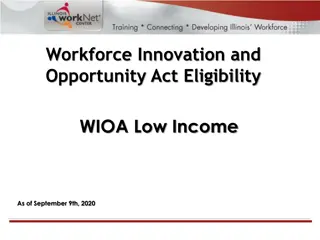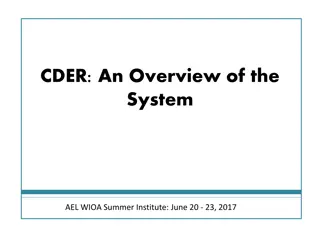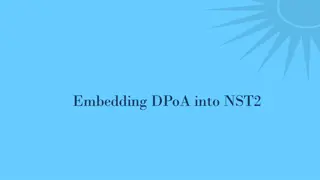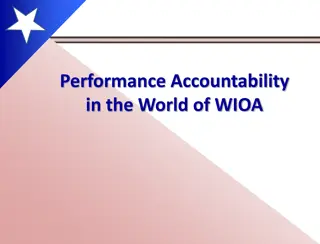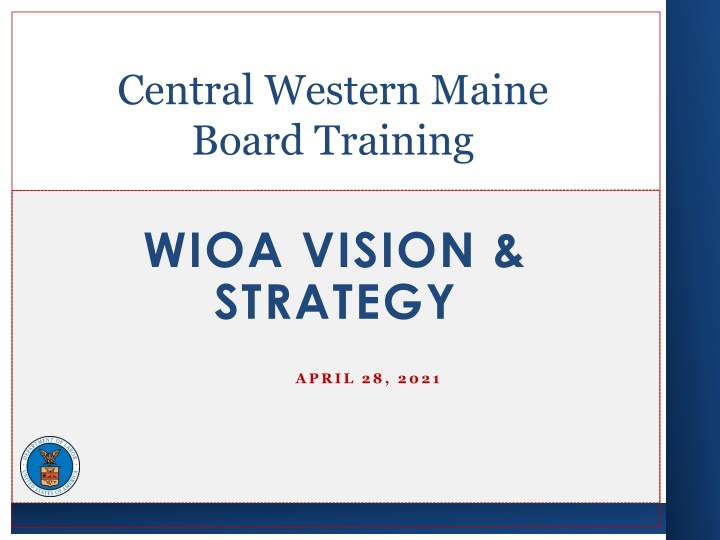
Investments in Maine: WIOA, UI, and Discretionary Funding Overview
Explore the investments in Maine focusing on Workforce Innovation and Opportunity Act (WIOA), Unemployment Insurance (UI), and discretionary funding. Learn about the grants, programs, and initiatives contributing to the state's workforce development. Dive into the strategic vision, breakdown of investments, and future goals to enhance the workforce system in the region.
Download Presentation

Please find below an Image/Link to download the presentation.
The content on the website is provided AS IS for your information and personal use only. It may not be sold, licensed, or shared on other websites without obtaining consent from the author. If you encounter any issues during the download, it is possible that the publisher has removed the file from their server.
You are allowed to download the files provided on this website for personal or commercial use, subject to the condition that they are used lawfully. All files are the property of their respective owners.
The content on the website is provided AS IS for your information and personal use only. It may not be sold, licensed, or shared on other websites without obtaining consent from the author.
E N D
Presentation Transcript
Central Western Maine Board Training WIOA VISION & STRATEGY APRIL 28, 2021
WIOA Vision 2 USDOL manages an investment of $20 billion dollars in over 2,200 grants. $17 Billion dollars are invested in programs operated by states $3 Billion is awarded in the form of discretionary grants. Other public investments in the workforce system. U.S. Department of Education, U.S. Department of Agriculture U.S. Department of Health and Human Services
WIOA INVESTMENTS IN MAINE 3 WIOA Formula Allotments in PY20/FY21: Adult($2.1M) Dislocated Worker ($2.6M) Youth ($2.2M) ES grant funds in PY20/FY21: WP($3.6M) WOTC ($15K) WIG ($325,566) Trade Investments FY21: o Trade Program Training & Other Activities - $356K o Alternative Trade Adjustment Allowance/Readjustment Trade Adjustment Allowance (ATAA/RTAA) $90K
UI INVESTMENTS IN MAINE 4 UI grant funds in FY21: UI administration ($13.6M) UI Supplemental Funding/COVID ($3.8M) CARES Act SBRs ($5.4M): FPUC: $384,420 PUA: $1,476,100 PUA FRAUD: $2,041,200 PEUC: $1,013,571 PEUC FRAUD: $388,800 MEUC: $150,000
DISCRETIONARY INVESTMENTS IN MAINE 5 Period of Performance 7/1/2020-9/30/2021 Grant Type Grantee Name Amount AC-National Farmworker Jobs Program Grant (NFJP) HG-Rural Healthcare MI Independent Initiative Grants (WDQI) DW National Health Emergency Grant (OPIOID) DW National Dislocated Worker (COVID- 19) PE-Federal Bonding Grant (SCSEP) Eastern Maine Development Corporation $219, 257 Coastal Counties Workforce Inc. Maine Department of Labor, Center for Workforce Beneath $2,500,000 2/1/2021 1/31/2025 $998,737 7/1/2019-6/30/2022 Maine Department of Labor $2,093,964 12/01/2019-12/31/2021 Maine Department of Labor $1,500,000 3/13/2020-6/30/2022 Maine Department of Labor Maine Department of Health and Human Services LearningWorks $34,500 7/1/2019-6/30/2023 $495,981 7/1/2020-6/30/2021 YB YouthBuild Grant YB YouthBuild Grant Apprenticeship State Expansion (ASE) State Apprenticeship Expansion (SAE) $1,080,000 1/1/2020-4/30/2023 Goodwill Industries of Northern New England Maine Department of Labor (MDOL) $1,227,101 1/1/2020-4/30/2023 $752,812 7/01/2019-6/30/2022 Maine Department of Labor (MDOL) $450,000 7/1/2020-6/30/2023
WIOA Vision 6 ETA envisions that all of these investments are part ofa comprehensive workforce system an aligned, flexible, and simplified state and local- driven system of workforce services and programs that brings together disparate workforce and education programs with a shared goal of achieving self-sufficiency for American workers and jobseekers.
KEY ASPECTS 7 Systemic collaboration of key workforce system partners to assessing & addressing customer needs; 1) Integrated service delivery that provides seamless & comprehensive services to customers; 2) Shared data for effective decision making & enhanced data collection; 3) Leverage resources across programs; and ultimately: 4) Improved employment outcomes through stronger connections between offered and training needed by employers. 5)
SYSTEMIC COLLABORATION 8 Customer-Centered Design Approach Formal Processes in place to promote collaborative vision (MOUs/Combined State Plans) Diversity of Workforce Board Appointments Serving the shared customer (TEGL 7-20) Establishment of integrated systems
INTEGRATED SERVICE DELIVERY 9 Establish integrated intake systems Develop an integrated workforce staff (cross-training) Encourage co-enrollment of programs Increase integrated virtual, on-line and offsite services
DATA-INFORMED SERVICES 10 Establish data systems that allow for key customer information (assessments, case notes, skill needs)/WIOA IT Support Center Analysis of customer data Review of outcomes data Accessing & sharing current labor market data
LEVERAGED RESOURCES 11 Leverage & braid public and private resources Be aware of other federally-funded workforce training services (HHS, SNAP, Commerce, HUD, Transportation & VETS)
OUTCOMES: BUSINESSES & JOB SEEKERS 12 Looking at qualitative & quantitative outcomes Prioritizing individuals most in need Creating transparency & accountability (www.trainingproviderresults.com)
AN INTEGRATED VISION IN ACTION 13 Unemployment Insurance (UI), Reemployment Services and Eligibility Assessment (RESEA), and WIOA Trade Adjustment Assistance (TAA) & WIOA Connections Expanding Apprenticeships TANF, SNAP & WIOA Connections Alignment of workforce programs in a single cabinet or department Innovative use of funding
14 Questions? MINNIE HOLLERAN HOLLERAN.MINNIE@DOL.GOV CARMEN RODRIGUEZ RODRIGUEZ.CARMEN@DOL.GOV


